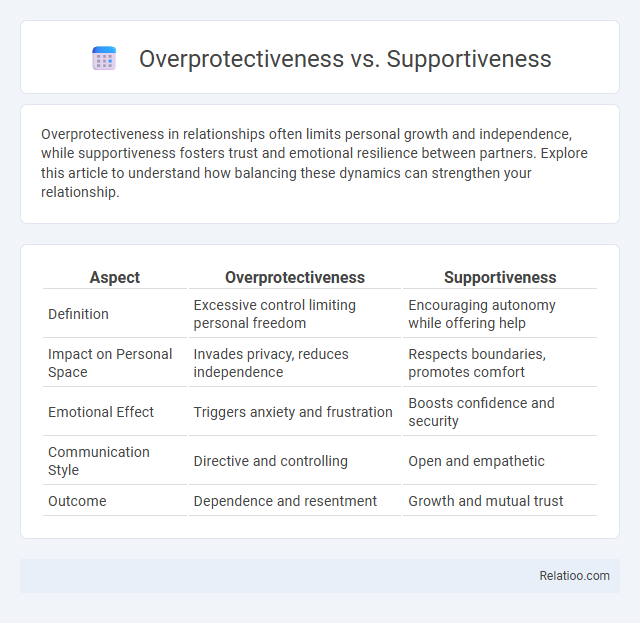Overprotectiveness in relationships often limits personal growth and independence, while supportiveness fosters trust and emotional resilience between partners. Explore this article to understand how balancing these dynamics can strengthen your relationship.
Table of Comparison
| Aspect | Overprotectiveness | Supportiveness |
|---|---|---|
| Definition | Excessive control limiting personal freedom | Encouraging autonomy while offering help |
| Impact on Personal Space | Invades privacy, reduces independence | Respects boundaries, promotes comfort |
| Emotional Effect | Triggers anxiety and frustration | Boosts confidence and security |
| Communication Style | Directive and controlling | Open and empathetic |
| Outcome | Dependence and resentment | Growth and mutual trust |
Understanding Overprotectiveness and Supportiveness
Understanding overprotectiveness involves recognizing behaviors that excessively restrict an individual's independence, often leading to reduced self-confidence and hindered personal growth. In contrast, supportiveness encourages autonomy while providing emotional and practical assistance that fosters resilience and empowerment. Balancing these approaches is critical to nurturing healthy development without stifling individual potential.
Key Differences Between Overprotectiveness and Supportiveness
Overprotectiveness involves excessive control and restriction that limits an individual's independence and decision-making, often leading to increased anxiety and reduced self-confidence. In contrast, supportiveness encourages autonomy by providing guidance, encouragement, and resources while respecting personal boundaries and choices. Key differences include the intent to control in overprotectiveness versus the intent to empower in supportiveness, with overprotectiveness potentially causing dependency and supportiveness fostering resilience and self-efficacy.
Signs of Overprotective Behavior
Signs of overprotective behavior include excessive control over Your decisions, constant monitoring of Your activities, and a reluctance to allow independence, which can hinder personal growth and self-confidence. Overprotectiveness often manifests as preventing You from taking risks or learning from failures, leading to increased anxiety and dependence. Recognizing these signs is crucial to fostering a supportive environment that balances care with respect for autonomy.
Traits of a Supportive Relationship
Supportive relationships are characterized by trust, open communication, and mutual respect, fostering an environment where each person feels valued and understood. Unlike overprotectiveness, which can limit autonomy and create dependency, supportiveness encourages growth, independence, and emotional resilience. Key traits include active listening, empathy, encouragement, and the ability to provide guidance without controlling behavior.
Psychological Impact on Children and Adults
Overprotectiveness often stifles autonomy, leading to increased anxiety and decreased self-efficacy in both children and adults. Supportiveness fosters resilience and healthy emotional development by encouraging problem-solving skills and independence. Balancing boundaries without crossing into overprotectiveness ensures Your psychological well-being is nurtured, promoting confidence and adaptive coping mechanisms.
Balancing Protection and Independence
Balancing protection and independence requires recognizing the fine line between overprotectiveness and supportiveness in your approach to care. Excessive overprotectiveness can stifle growth and autonomy, while supportiveness fosters confidence and resilience by encouraging healthy risk-taking and decision-making. Your goal is to provide guidance without restrictions, enabling independence while ensuring safety.
Effects on Emotional Development
Overprotectiveness can hinder your child's emotional development by limiting their opportunities to face challenges and build resilience. Supportiveness fosters emotional growth by encouraging autonomy and helping children develop healthy coping mechanisms. Excessive control or overprotection impairs self-confidence and problem-solving skills essential for emotional maturity.
Parenting Styles: Overprotective vs Supportive
Overprotective parenting often limits a child's independence by constantly shielding them from failure and risk, which can hinder the development of critical problem-solving skills and self-confidence. Supportive parenting encourages autonomy while providing guidance, fostering resilience and healthy emotional growth by allowing children to learn from their experiences. Balancing protection with support helps children develop a secure sense of competence and emotional stability, essential for navigating challenges effectively.
Strategies to Transition from Overprotectiveness to Supportiveness
Shifting from overprotectiveness to supportiveness involves fostering trust and encouraging independence in Your relationships while maintaining clear boundaries and open communication. Implementing strategies such as active listening, validating emotions, and providing guidance without micromanaging helps nurture autonomy and confidence. Establishing gradual exposure to challenges empowers others to develop problem-solving skills and resilience, promoting a balanced, supportive dynamic.
Building Healthy Boundaries and Trust
Building healthy boundaries and trust requires a balance between overprotectiveness and supportiveness; excessive protection can hinder autonomy, while supportive behavior fosters confidence and independence. Establishing clear limits respects personal space and promotes open communication, which strengthens mutual trust over time. Encouraging responsibility within a supportive framework helps individuals develop resilience and secure relationships.

Infographic: Overprotectiveness vs Supportiveness
 relatioo.com
relatioo.com